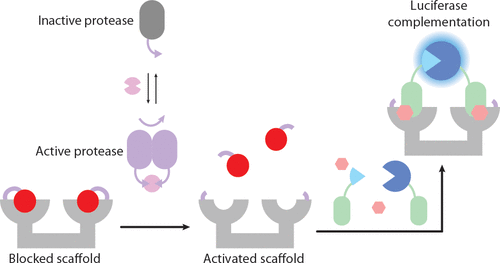当前位置:
X-MOL 学术
›
ACS Synth. Biol.
›
论文详情
Our official English website, www.x-mol.net, welcomes your
feedback! (Note: you will need to create a separate account there.)
Protease-Activatable Scaffold Proteins as Versatile Molecular Hubs in Synthetic Signaling Networks.
ACS Synthetic Biology ( IF 3.7 ) Pub Date : 2018-08-31 , DOI: 10.1021/acssynbio.8b00217 Stijn J A Aper 1 , Anniek den Hamer 1 , Simone F A Wouters 1 , Lenne J M Lemmens 1 , Christian Ottmann 1 , Luc Brunsveld 1 , Maarten Merkx 1
ACS Synthetic Biology ( IF 3.7 ) Pub Date : 2018-08-31 , DOI: 10.1021/acssynbio.8b00217 Stijn J A Aper 1 , Anniek den Hamer 1 , Simone F A Wouters 1 , Lenne J M Lemmens 1 , Christian Ottmann 1 , Luc Brunsveld 1 , Maarten Merkx 1
Affiliation

|
Protease signaling and scaffold-induced control of protein-protein interactions represent two important mechanisms for intracellular signaling. Here we report a generic and modular approach to control the activity of scaffolding proteins by protease activity, creating versatile molecular platforms to construct synthetic signaling networks. Using 14-3-3 proteins as a structurally well-characterized and important class of scaffold proteins, three different architectures were explored to achieve optimal protease-mediated control of scaffold activity, fusing either one or two monovalent inhibitory ExoS peptides or a single bivalent ExoS peptide to T14-3-3 using protease-cleavable linkers. Analysis of scaffolding activity before and after protease-induced cleavage revealed optimal control of 14-3-3 activity for the system that contained monovalent ExoS peptides fused to both the N-and C-terminus, each blocking a single T14-3-3 binding site. The protease-activatable 14-3-3 scaffolds were successfully applied to construct a three-step signaling cascade in which dimerization and activation of FGG-caspase-9 on an orthogonal supramolecular platform resulted in activation of a 14-3-3 scaffold, which in turn allowed 14-3-3-templated complementation of a split-luciferase. In addition, by combining 14-3-3-templated activation of caspase-9 with a caspase-9-activatable 14-3-3 scaffold, the first example of a synthetic self-activating protease signaling network was created. Protease-activatable 14-3-3 proteins thus represent a modular platform whose properties can be rationally engineered to fit different applications, both to create artificial in vitro synthetic molecular networks and as a novel signaling hub to re-engineer intracellular signaling pathways.
中文翻译:

蛋白酶激活支架蛋白作为合成信号网络中的多功能分子中心。
蛋白酶信号传导和支架诱导的蛋白质-蛋白质相互作用控制代表了细胞内信号传导的两个重要机制。在这里,我们报告了一种通用和模块化的方法,通过蛋白酶活性控制支架蛋白的活性,创建通用的分子平台来构建合成信号网络。使用 14-3-3 蛋白作为结构良好且重要的一类支架蛋白,探索了三种不同的结构,以实现对支架活性的最佳蛋白酶介导控制,融合一个或两个单价抑制性 ExoS 肽或单个二价 ExoS使用蛋白酶可切割的接头将肽连接到 T14-3-3。蛋白酶诱导的切割前后支架活性的分析揭示了对包含融合到 N 端和 C 端的单价 ExoS 肽的系统的 14-3-3 活性的最佳控制,每个肽阻断单个 T14-3-3 结合地点。蛋白酶可激活的 14-3-3 支架成功应用于构建三步信号级联,其中 FGG-caspase-9 在正交超分子平台上的二聚化和激活导致 14-3-3 支架的激活,其反过来允许分裂荧光素酶的14-3-3模板互补。此外,通过将 caspase-9 的 14-3-3 模板激活与 caspase-9 可激活的 14-3-3 支架相结合,创建了合成自激活蛋白酶信号网络的第一个示例。
更新日期:2018-08-20
中文翻译:

蛋白酶激活支架蛋白作为合成信号网络中的多功能分子中心。
蛋白酶信号传导和支架诱导的蛋白质-蛋白质相互作用控制代表了细胞内信号传导的两个重要机制。在这里,我们报告了一种通用和模块化的方法,通过蛋白酶活性控制支架蛋白的活性,创建通用的分子平台来构建合成信号网络。使用 14-3-3 蛋白作为结构良好且重要的一类支架蛋白,探索了三种不同的结构,以实现对支架活性的最佳蛋白酶介导控制,融合一个或两个单价抑制性 ExoS 肽或单个二价 ExoS使用蛋白酶可切割的接头将肽连接到 T14-3-3。蛋白酶诱导的切割前后支架活性的分析揭示了对包含融合到 N 端和 C 端的单价 ExoS 肽的系统的 14-3-3 活性的最佳控制,每个肽阻断单个 T14-3-3 结合地点。蛋白酶可激活的 14-3-3 支架成功应用于构建三步信号级联,其中 FGG-caspase-9 在正交超分子平台上的二聚化和激活导致 14-3-3 支架的激活,其反过来允许分裂荧光素酶的14-3-3模板互补。此外,通过将 caspase-9 的 14-3-3 模板激活与 caspase-9 可激活的 14-3-3 支架相结合,创建了合成自激活蛋白酶信号网络的第一个示例。











































 京公网安备 11010802027423号
京公网安备 11010802027423号